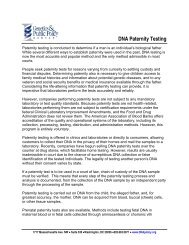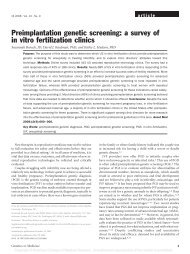Preimplantation Genetic Diagnosis - Genetics & Public Policy Center
Preimplantation Genetic Diagnosis - Genetics & Public Policy Center
Preimplantation Genetic Diagnosis - Genetics & Public Policy Center
Create successful ePaper yourself
Turn your PDF publications into a flip-book with our unique Google optimized e-Paper software.
PGD for a Privileged Few?<br />
Addressing Access to Services<br />
PGD is expensive. It requires IVF, which costs on<br />
average $10,000-$12,000. The addition of PGD can add<br />
$2,500-$4,000, bringing the total cost to approximately<br />
$12,500-$16,000.<br />
Insurers may not cover PGD at all, or may pay only for the<br />
genetic testing, leaving prospective parents to pay for the IVF.<br />
Without coverage, PGD is available primarily to those who<br />
can pay significant out-of-pocket costs. Families who would<br />
face the greatest financial burden of caring for children born<br />
with conditions detectable via PGD may be the ones least able<br />
to afford it.<br />
Many insurers do not cover IVF for infertility treatment or<br />
offer a limited benefit. Some fertility clinics offer ways to<br />
make IVF more affordable. Fifteen states have enacted some<br />
type of infertility insurance coverage law. There are no federal<br />
laws in this area.<br />
There has been no systematic investigation of insurance<br />
coverage practices for PGD. Anecdotal evidence suggests that<br />
when families are using PGD to avoid serious genetic<br />
disorders, insurance companies are more willing to consider<br />
the PGD medically necessary and cover the cost. At least one<br />
insurance company covers the genetic testing component of<br />
PGD for detection of inherited genetic disorders but not for<br />
aneuploidy. However, that company will not cover IVF if used<br />
only to perform PGD.<br />
PGD is not unique in terms of its current level of relatively<br />
limited access. Most new medical technologies are first used<br />
by a small number of people who participate in research<br />
studies or who can afford to pay for them out-of-pocket.<br />
Broader use occurs when these techniques become the<br />
standard of care and health insurers agree to pay for them.<br />
The issue for PGD is whether and when this transition will<br />
occur.<br />
“I just think it is inevitable that we<br />
come down to who can pay for it, or<br />
can get their health insurance to pay<br />
for it. So I can see it being regulated<br />
by the health insurance companies<br />
being willing to cover certain<br />
diseases.”<br />
“I think that’s a real fear, that health<br />
insurance companies might say, ‘if<br />
you don’t have this test, or you don’t<br />
have this procedure, we are not<br />
going to pay to take care of that ill<br />
child that you have.’”<br />
For insurers, the question of whether to cover any medical<br />
procedure or test primarily comes down to an analysis of the<br />
potential costs and benefits of coverage. A cost-benefit<br />
analysis of PGD would have to take into account the cost of<br />
the underlying IVF, the embryo biopsy and the genetic testing.<br />
It is not clear whether any health insurer in this co untry has<br />
undertaken a formal cost-benefit analysis of PGD for<br />
inherited genetic disorders.<br />
22<br />
VISIT WWW.DNAPOLICY.ORG TO COMMENT










